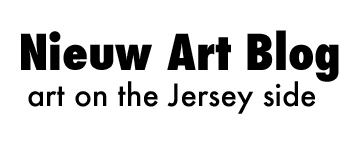Response to “Neither Here and There,” an exhibition by PE Pinkman
By Mona Brody
April 4, 2024
A single self-portrait can offer a provocative glance into an artist’s private life. But when one has an opportunity to view and explore 100 portraits from 100 days, a visual cacophony occurs. Artist PE Pinkman offers the viewer that opportunity in his series, “100 Days of a Pandemic” and “Not Who You See(m)” as part of the broader exhibition on view, “Neither Here and There” displayed in The Alcove Gallery at Drawing Rooms, 926 Newark Avenue, Jersey City, NJ, curated by Anne Trauben.
Pinkman’s series, “100 Days of a Pandemic,” allowed me to be a voyeur of sorts, as I delved into the inner life of a man’s psyche, emotional state, and various identities. This diaristic practice began January 1, 2021, nine months after the Covid Pandemic started and concluded April 11, 2021. PE Pinkman was completely into the throes of a global pandemic, unbridled disinformation, Black Lives Matter protests, an election unlike any in history, unprecedented vaccine development, and general mistrust.
It was clear to me that his commitment to this daily practice of drawing one drawing a day for 100 days, while isolated in a small apartment, was a necessary process of reflection and self-healing. This practice allowed him to find the motivation and ultimately the content for this self-directed series. Begun in a time of introspection, the series morphed into an important and profound work of art.
Francis Bacon’s self-portrait series from 1975, "I've Had Else to Paint but Myself", cries out to me in the same manner as Pinkman’s series. Both artists face solitude and fear in a delicate balance of sanity, fantasy, and response to a challenging world.

I've Had Nobody Else to Paint but Myself by Francis Bacon
14 x 12 inches, oil on canvas
Pinkman’s other series of self-portraits from birth to a futuristic view as him as an older man, "Not Who You See(m)" takes us through the stages of his life, experiences, and challenges. Materials and touch allow the memory of youth and the reality of age and wisdom to emerge.
#60, 14 x 11 in, graphite on paper
While responding to PE Pinkman’s drawings from this series, I had the desire to revisit Rembrandt’s archive of self-portraits. Rembrandt’s self-portraits have been an important example of documenting and recording self-exploration for artists over the centuries, and they continue to this day. I am fascinated by the psychological intensity of Rembrandt’s late self-portraits and its relationship to Pinkman’s drawing of how he sees himself now.

Self-portrait looking in a mirror, Rembrandt van Rijn, Age 63,
possibly black conte on laid paper, 1669
























